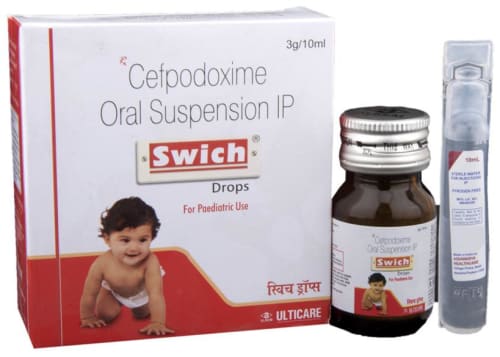

Cefpodoxime Proxetil (25mg)
Give this medicine to your child an hour before or two hours after meals. If your child develops a stomach upset, prefer giving it with food. Make sure to stick to the prescribed dose because it is given keeping in mind the type of infection, its severity, and the age and bodyweight of your child. In case your child gags and expels the medicine within 30 mins of intake, repeat the same dose but do not double the dose if it's the time for the next dose. Do not give this medicine to your child in case of cold and flu symptoms as this medicine is an antibiotic and doesn’t work on infections caused by viruses. Doctors prescribe this medicine for cough and cold only when they detect any underlying secondary bacterial infection. Some of the minor and temporary side effects of this medicine include vomiting, diarrhea, nausea, rash, and headache. Usually, these episodes subside once your child’s body adapts to the medicine. However, if these effects persist or become bothersome for your child, call the doctor right away.Narrate your child’s complete medical history to your child’s doctor, including any previous episodes of allergy, heart problem, blood disorder, birth defects, airway obstruction, lung anomaly, gastrointestinal problem, skin disorder, liver impairment, and kidney malfunction. This information is critical for dose alterations and for planning your child’s overall treatment.
Most side effects do not require any medical attention and disappear as your body adjusts to the medicine. Consult your doctor if they persist or if you’re worried about themCommon side effects of Swich
10 ml Oral Suspension
Image shown is a representation and may slightly vary from the actual product. Every effort is made to maintain accuracy of all information displayed.
Take this medicine in the dose and duration as advised by your doctor. Check the label for directions before use. Measure it with a measuring cup and take it by mouth. Shake well before use. Swich Drops is to be taken with food.
Swich Drops is an antibiotic. It works by preventing the formation of the bacterial protective covering (cell wall) which is essential for the survival of the bacteria. By doing so, this medicine stops the infection-causing bacteria from growing further and prevents the infection from spreading without making the bacteria resistant to further treatment.
Related Warnings
Consuming alcohol with Swich Drops does not cause any harmful side effects.
Swich Drops is generally considered safe to use during pregnancy. Animal studies have shown low or no adverse effects to the developing baby; however, there are limited human studies.
Swich Drops is safe to use during breastfeeding. Human studies suggest that the drug does not pass into the breastmilk in a significant amount and is not harmful to the baby.
Avoid prolonged use of Swich Drops, since it may have possible effects such as rash and diarrhea.
Swich Drops may decrease alertness, affect your vision or make you feel sleepy and dizzy. Do not drive if these symptoms occur.
Swich Drops is safe to use in patients with kidney disease. No dose adjustment of Swich Drops is recommended.
However, dose modifications may be required in children with severe kidney disease.
Swich Drops should be used with caution in patients with liver disease. Dose adjustment of Swich Drops may be needed. Please consult your doctor.
An extra dose of Swich Drops is unlikely to do harm. However, if you think you have given too much of Swich Drops to your child, immediately speak to a doctor. Overdose may cause unwanted side effects and may even worsen your child’s condition.
Some serious side effects of this medicine include persistent vomiting, kidney damage, allergy, diarrhea, and severe gastrointestinal infections. Always consult your child’s doctor for help in such a situation.
Avoid giving Swich Drops along with medicines like Aminoglycosides such as amikacin, gentamicin, streptomycin, anticoagulants (blood-thinners) such as warfarin, PPIs like Pentaprozole, and H2 blockers such as Famotidine. Before you start giving Swich Drops to your child, let your child’s doctor know if your child is taking any of the above-mentioned medicines.
It is advised to inform the doctor if your child is taking Swich Drops at the time of vaccinations like BCG, cholera, and typhoid as Swich Drops can neutralize the effect of these vaccines.
The doctor may prescribe getting kidney function tests and liver function tests periodically to keep a check on your child’s condition.
Yellow or green mucus in the nose does not mean that antibiotics are needed. During a common cold, it is normal for mucus to thicken up and change from clear to yellow or green. Symptoms often last for 7-10 days.
No. More than 80% of sore throats and ear infections are caused by a virus and antibiotics are not given for viral infections. If your child has a sore throat, runny nose, a barky cough, pain, and discharge from the ear, it is most likely because of a virus. Consult your child’s doctor to seek guidance.
In most cases, bacterial infections do not follow viral infections. Using antibiotics to treat viral infections may instead lead to side effects without benefiting your child's health. Use antibiotics only after consulting with your child’s doctor.
Children often have a sensitive stomach and develop a stomach upset while taking antibiotics. When antibiotics are given, the good bacteria in their gastrointestinal tract may take a hit too. Swich Drops may kill off the good bacteria along with the bad, increasing the risk of developing other infections. In case your child is having diarrhea while on Swich Drops, do not stop the medicine course. Instead, call your child’s doctor to ask about the next steps. In some cases, the doctor may alter the dose.
Yes, irregular treatment, repeated use, and misuse of Swich Drops can lead to resistance. Resistant bacteria are no longer killed by the antibiotics and may lead to reinfection.